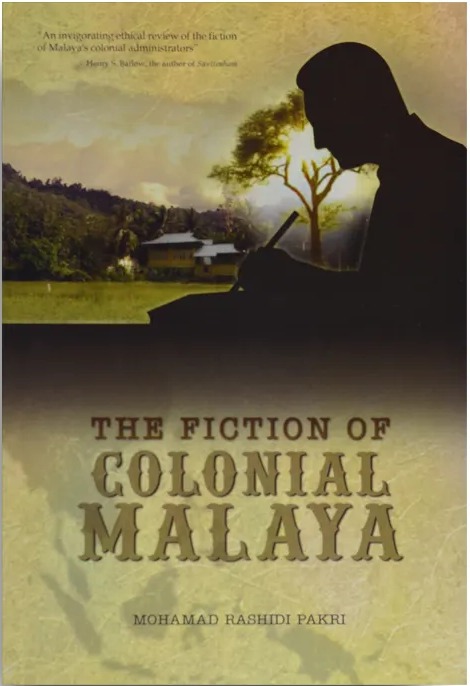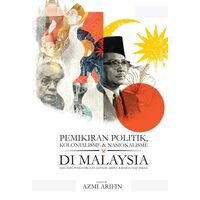The Fiction of Colonial Malaya
Author: Mohamad Rashidi Pakri
Publisher: USM Press
ISBN: 9789838618458
Pages: 102pp
Year: 2014
Weight: 0.214kg
Price: RM30
The subject matter of this book, The Fiction of Colonial Malaya, has curiously never been introduced in any other study, either to the specific Malayan or the mixed-race Malaysian people, simply because it was never intended for their consumption. The colonial fiction discussed here is all about Malaya/Malaysia and its people, but it has never truly ‘belonged’ to the Malays. Unlike E.M. Foster’s Passage to India (1924) or Rudyard Kipling’s Kim (1901) which both feature an Indian setting and are well established as great works of English literature, the works of fiction by the colonial officers in Malaya such as Sir Frank Swettenham, Sir Hugh Clifford, Sir George Maxwell and Anthony Burgess have not received any such critical attention or acclaim. Although other famous writers such as Joseph Conrad (Lord Jim, 1900 and Heart of Darkness, 1902) and William Somerset Maugham capitalised on their encounters with the people of the Malay archipelago during their short sojourns in this part of the world, their contact and knowledge are limited to interaction with the expatriates at Penang and Singapore. In the case of Maugham, in for example Maugham’s Malaysian Stories (1969) and Maugham’s Borneo Stories (1976), it is more than likely that those narratives are based on the conversation with his local expatriate friends.
However, Malaysians are, in general, beginning to claim their colonial past and its literary treasures, as indicated recently by the lifting of the ban on The Malayan Trilogy, Anthony Burgess’s controversial text written by during the tumultuous period leading up to the country’s independence in 1957. This book is now available in many bookstores such as Borders and Malaysian Publishing House (MPH). On a similar note, a reprint of other colonial texts such as Hugh Clifford’s Since the Beginning should also be carried out in order to make the text available to the general public, as it is considered a rare book and has been out of print since it was first published by G. Richards in 1898. Burgess’s work will be discussed in the final chapter of this book, as it provides a neat demarcation between the colonial and postcolonial eras in Malaya/Malaysia, and also coincides with the beginning of a post-independence literary boom, if not movement, in Malaysia.
Therefore, despite the aforementioned originality of The Fiction of Colonial Malaya, in the sense that it brings the featured texts to the attention of a new generation of post-independence, postcolonial readers, it ‘re-introduces’ the featured texts to Malaysians in particular and global others in general. This re-introduction of the texts and the colonial authors will be covered, appropriately enough in this introduction. More importantly, The Fiction of Colonial Malaya provides critical analysis of the texts, largely through establishing the historical context of colonial ideology and the application of postcolonial theory, which approach the author hope many students new to the field of postcolonial literature and theory will find highly informative. As befitting a study one of the titular aims of which is to explore the literary and broader ideological implications of the term ‘fiction’, the author have chosen as the focus of his analysis, with other modes of writing in a supplementary role, the literary genre itself of fiction. Within this analysis, the author refers only briefly to all stories that revolve around issues or subjects relating to ‘running amok’ (a notorious behavioural habit stereotypically attributed to the Malay race), latah, and other superstitious beliefs. Although all are individually and collectively, interesting and important subjects, they are indeed interesting and important enough to warrant independent study.
The first colonial author to be discussed is Frank Swettenham. His works of fiction were written and mostly published while he was on home leave during the last period of his active life from 1901 to 1904. His career in the British Civil Service in Malaya lasted from 1871 until 1904. His first work, Malay Sketches, was published in 1895. Then came Unaddressed Letters in 1898, the year he was knighted. The Real Malay followed shortly after that in 1899. In 1912, he published British Malaya, which was considered a “standard [historical] work on the Peninsula, until the revisions by Parkinson and Malaysian historians in the 1960s”. Also and Perhaps appeared in 1914. His last works, as far as Malaya is concerned, Footprints in Malaya, was more overtly autobiographical and was published in 1942, the year his good friend and colleague in Malaya, Sir Hugh Clifford passed away, and four years before his own death in 1946. Of the six works mentioned above, selected short stories from Malay Sketches, Unaddressed Letters and The Real Malay will be discussed in detail in this book, since they involve fictionalised versions of the real-life Malays under his authority. Footprints in Malaya and British Malaya will be used in a secondary, supportive capacity, since they are, respectively, of an autobiographical and historical tenor.
The works of fiction covered in this book which was written by Hugh Clifford, Were written mostly during his time in Malaya from 1883 until 1904 when he left for Trinidad. The writings actually began during his stay in Pahang as a Resident. With hard, diligent work and a sufficient degree of enthusiasm to learn the Malay language, Clifford passed the colonial service’s language examination, a compulsory requirement by then, in 1885. Being able to speak Malay gave him many advantages, personally and professionally, both as a British Resident to the Sultan of Pahang and the writer of Malayan fiction, as many of his stories, Clifford claimed, had “been told to me by natives,”. His works of fiction written during this period are In Court and Kampong (1897a), Studies in Brown Humanity (1897b), Since the Beginning (1898), In a Corner of Asia (1899), Bushwhacking (1901/1929), A Free Lance of Today (1903) and Saleh: Prince of Malaya (1926a).
The next colonial author is Sir George William Maxwell, who was the first British Advisor to Kedah, and the third generation of the family to serve in Malaya. His father, Sir William Edward Maxwell (1846-1897) was a keen scholar in the field of Malay studies and had been a contributor to the Journal of the Strait Branch of the Royal Asiatic Society since 1876. Sir William also introduced the important Torrens System of land registration to Malaya in 1884. In 1856, Sir Peter Benson Maxwell, being of the first generation, travelled to Penang to take up his position as a Supreme Court Judge, where he remained until he retired as the Chief Judge of the Straits Settlements in April 1871. In 1878, Sir P.B. Maxwell wrote a book entitled Our Malay Conquests, which “viewed with horror British intervention in Perak in the mid-187Os”.
Seemingly influenced by his father’s sympathetic attitude to the Malays, Sir George promoted an appreciation of Malay customs as the basis of how to approach and govern the people. Sir George, later known as a naturalist, wrote a book entitled In Malay Forests (1907) and was responsible for the development of hill stations in Malaya such as Cameron Highlands and Frasers Hill. The fact that he did not become a Malay scholar like his father, Sir William Edward Maxwell or his grandfather, Sir Peter Benson Maxwell, need not suggest that Sir George knew nothing about Malay culture. In fact, his book includes a close study of Malay folklore and many enchanting tales which provide proof of his ability in both the language and culture. It is the evidence of the Malay adat (customs) from his book, upon which this chapter is based, and it is worth noting the inclusion of stories like “A Deer-Drive”, “Crocodile Catching”, “A Fish-Drive” and “A Tiger-Drive”. These titles reflect the native and local sporting activities with which Sir George pursued an active interest.
Rashidi’s final colonial author is Anthony Burgess, whose actual name was John Burgess Wilson (1917-1993). The multi-talented Burgess was a novelist, poet, playwright, music composer, linguist, translator, critic and in relation to Malaya, teacher and education officer. His most famous and thought-provoking work in the consciousness of western readers (partially at least thanks to Stanley Kubrick’s film adaptation in 1971) is A Clockwork Orange (1962), but by then he had already published a controversial collection of stories in relation to the politics of Malaya/Malaysia, The Malayan Trilogy which was written during his employment in Malaya between 1954 and 1958. Burgess came to Malaya in 1954 to fill in a teaching post in Malay College Kuala Kangsar (MCKK). He taught at that school for a year and was the housemaster to the students of the preparatory school. A year later he moved to the state of Kelantan, where he was posted to the Malay Teachers’ Training College in Kota Bharu as an education officer until 1958. Throughout his four years stay in Malaya, Burgess wrote a trilogy titled The Long Day Wanes: The Malayan Trilogy, which was his first-time attempt to write professionally. Prior to their collection in The Trilogy, the three stories appeared as follows: Time for a Tiger in 1956, The Enemy in the Blanket in 1958, and Beds in the East in 1959.
The novels of The Malayan Trilogy were all written in the exciting but uncertain years immediately preceding and succeeding the arrival of independence, after more than eighty years of British colonial rule. Burgess had come to Malaya at a time when there was a lot of political and racial tension between the colonial British and the diverse races of Malaya. The Malayans/Malaysians themselves were questioning the possibility of achieving national unity because of the self-interest of the Malays, and the uncertain sense of belonging and national identity among the Indians and Chinese, in this newly-formed, multicultural nation. It seems that Burgess’s arrival in Malaya in 1954 presented the perfect time and place for the author to gain that acute sense of the correlation between private life and public history which is vital to the writing vocation.
Burgess came to Malaya with very little knowledge of the actual state of Malaya because the only introduction he had was from George Orwell’s Burmese days, Maugham’s Malayan short stories, Conrad’s fiction and the works of Rudyard Kipling. Burgess later said of the beginning of his writing career that “…I went to Malaya as an education officer in 1954 and was so enchanted with the country and angry with Somerset Maugham for writing all that stuff about planter’s wives that I began writing my Malayan trilogy. I found it easy enough to write there—you sweat so much that it seems to encourage you sweating out words.”
Burgess’s figurative sweating-out of his fiction is highly suggestive, here. The foreign climate causes a physical reaction in the British author, that of sweating, which normally denotes strenuous labour or intense fear, but which here, conversely facilitates creativity or the easy, free flow of ideas and their written expression. Malaya, by its very foreignness, makes an author out of Burgess













